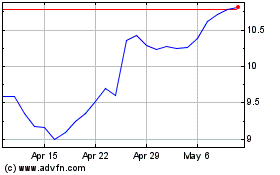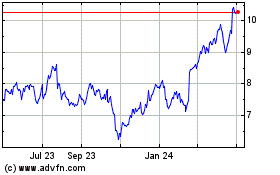A Radical About-Face for Battle-Scarred Barclays: Take More Risk
March 08 2017 - 5:59AM
Dow Jones News
By Max Colchester
Barclays PLC's new corporate-and-investment-banking chief, Tim
Throsby, recently toured his unit spreading a message that staff
haven't heard for years: Don't be afraid to take more risk.
Since his arrival in January, Mr. Throsby has told staff at
meetings to reawaken their "commercial instincts" and use more of
the bank's risk appetite, these people say.
On Tuesday, he promoted Art Mbanefo, a lieutenant who will be
charged with helping manage Barclays International's balance sheet,
according to a memo sent to staff. Mr. Mbanefo's job is to squeeze
capital out of the unit that can be redeployed to juice up returns.
He will work across Barclays' biggest revenue generator,
encompassing the lender's investment bank, big corporate clients
and its U.S. credit-card business.
The move to reinvigorate the unit marks a turning point for the
bank. European lenders have spent years shrinking their
investment-banking businesses amid increased regulatory pressure to
limit risk-taking. In 2008, Barclays acquired a chunk of the old
Lehman Brothers franchise in a bid to build a global investment
bank. But after a wave of scandals, management put the emphasis
back on the U.K. lender's retail franchise.
Now, under Barclays Chief Executive Jes Staley the pendulum is
swinging back. While rivals Deutsche Bank AG and Credit Suisse
Group AG continue to reshape their investment-banking franchises,
Barclays says it is approaching the end of that process. Last year
it largely pulled out of Asia and refocused on the U.S. and U.K.
Like other diversified banks, Barclays' share price has risen
nearly a third over the last 12 months thanks to the prospect of
rising rates in the U.S. Investment-bank executives hope they can
ride a wave of market volatility to generate more returns.
Some bankers, scarred by the years of cuts and restructuring,
have held back from taking decisions that are still within the
bank's risk parameters. Mr. Throsby wants that mentality to change,
according to people familiar with the matter.
Nevertheless, investors continue to question whether Barclays'
investment bank can generate solid returns. The unit had a return
on equity -- a key measure of profitability -- of 6% in 2016.
Investors want it to generate double-digit return on equity. Key to
that will be Mr. Throsby's ability to do more business without
asking his boss for extra capital.
Unlike at its major U.S. rivals, capital remains tight at
Barclays. The bank slashed dividends to pay for a cleanup of its
balance sheet, which is expected to be completed by the end of June
this year.
Mr. Mbanefo's job will be to ensure Barclays International's
balance sheet is run efficiently. This should free up capital that
can then be plowed back into the franchise to increase returns.
So far potential growth areas that have been identified by Mr.
Throsby include the bank's U.S. credit-card business, these people
say. The executive also is planning to review of its U.K. corporate
business to focus on clients that generate what the bank considers
appropriate returns, these people say. The investment bank hopes to
grow returns by increasing business cross-selling to existing
clients.
Write to Max Colchester at max.colchester@wsj.com
(END) Dow Jones Newswires
March 08, 2017 05:44 ET (10:44 GMT)
Copyright (c) 2017 Dow Jones & Company, Inc.
Barclays (NYSE:BCS)
Historical Stock Chart
From Mar 2024 to Apr 2024

Barclays (NYSE:BCS)
Historical Stock Chart
From Apr 2023 to Apr 2024
